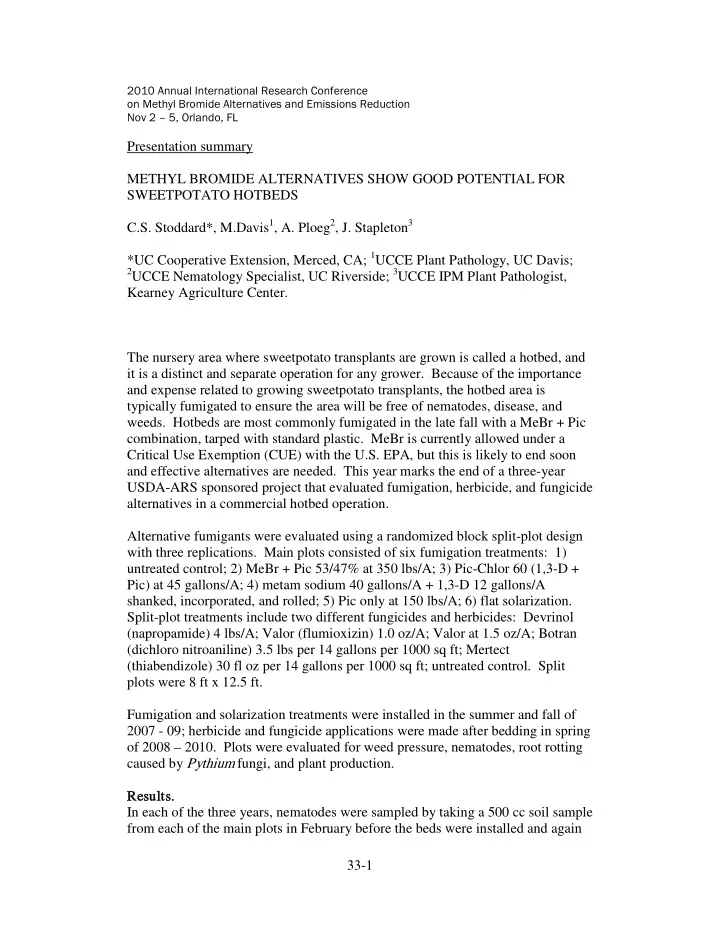

2010 Annual International Research Conference on Methyl Bromide Alternatives and Emissions Reduction Nov 2 – 5, Orlando, FL Presentation summary METHYL BROMIDE ALTERNATIVES SHOW GOOD POTENTIAL FOR SWEETPOTATO HOTBEDS C.S. Stoddard*, M.Davis 1 , A. Ploeg 2 , J. Stapleton 3 *UC Cooperative Extension, Merced, CA; 1 UCCE Plant Pathology, UC Davis; 2 UCCE Nematology Specialist, UC Riverside; 3 UCCE IPM Plant Pathologist, Kearney Agriculture Center. The nursery area where sweetpotato transplants are grown is called a hotbed, and it is a distinct and separate operation for any grower. Because of the importance and expense related to growing sweetpotato transplants, the hotbed area is typically fumigated to ensure the area will be free of nematodes, disease, and weeds. Hotbeds are most commonly fumigated in the late fall with a MeBr + Pic combination, tarped with standard plastic. MeBr is currently allowed under a Critical Use Exemption (CUE) with the U.S. EPA, but this is likely to end soon and effective alternatives are needed. This year marks the end of a three-year USDA-ARS sponsored project that evaluated fumigation, herbicide, and fungicide alternatives in a commercial hotbed operation. Alternative fumigants were evaluated using a randomized block split-plot design with three replications. Main plots consisted of six fumigation treatments: 1) untreated control; 2) MeBr + Pic 53/47% at 350 lbs/A; 3) Pic-Chlor 60 (1,3-D + Pic) at 45 gallons/A; 4) metam sodium 40 gallons/A + 1,3-D 12 gallons/A shanked, incorporated, and rolled; 5) Pic only at 150 lbs/A; 6) flat solarization. Split-plot treatments include two different fungicides and herbicides: Devrinol (napropamide) 4 lbs/A; Valor (flumioxizin) 1.0 oz/A; Valor at 1.5 oz/A; Botran (dichloro nitroaniline) 3.5 lbs per 14 gallons per 1000 sq ft; Mertect (thiabendizole) 30 fl oz per 14 gallons per 1000 sq ft; untreated control. Split plots were 8 ft x 12.5 ft. Fumigation and solarization treatments were installed in the summer and fall of 2007 - 09; herbicide and fungicide applications were made after bedding in spring of 2008 – 2010. Plots were evaluated for weed pressure, nematodes, root rotting caused by Pythium fungi, and plant production. Resu sults. s. In each of the three years, nematodes were sampled by taking a 500 cc soil sample from each of the main plots in February before the beds were installed and again 33-1
at plant harvest in May. No root knot nematodes ( Meloidogyne incognita) or other plant parasitic nematodes were found at any sampling event. Similar to nematodes, the soil analysis for potential root rotting pathogens showed no significant differences among treatments in any year. Initial weed pressure was not that high in the area where these hotbeds were located, probably because it had been previously fumigated with MeBr, but weed pressure and diversity increased as the trial progressed. Significant differences occurred between the main plot treatments, with greatest number of weeds in the untreated (UTC) and solarization treatments. These treatments also required the most hand weeding time, averaging 97 and 73 seconds per 100 ft 2 (Figure 1). Significant differences were also noted between the split plot treatments for weed control. Application of either herbicide significantly reduced weed pressure as compared to not treating, with Valor having the greatest efficacy on the weeds present at this location (puncture vine, malva, pigweed, mustard, and barnyard grass dominated). However, Valor caused some noticeable crop phytotoxicity in each year of this trial. A reduction in plant production was noticed in 2009, but this was not seen in 2008 or 2010. No significant impact on plant production was noted in 2010 from either the herbicide or fumigation treatments as compared to the untreated control (Figure 2). Results in 2010 closely resemble what was observed in the first two years of this trial: weeds are the main pest issue sweetpotato growers must contend with in the hotbed area. Nematodes are a non-issue, probably because the amount of time in the hotbeds is not long enough for nematode populations to increase to levels that could damage plants or be transported to the field. Thus, the Telone + Vapam treatment has been the most effective and economical alternative to MeBr. Unfortunately, solarization has not been that effective in controlling weeds, probably a result of the length of time between treatment in the summer and bedding the following spring. The use of pre-plant herbicides Devrinol or Valor significantly improved weed control, especially in the Pic only, solarization, and untreated alternatives. This research suggests that MeBr is not necessary for sweetpotato hotbeds in California, and that weed control can be obtained by judicious use of fumigation alternatives such as Telone, metam, or the combination thereof, or no fumigants at all when herbicides are used. Further work is planned to verify these results, which were done at one location, with additional commercial growers. 33-2
Figure 1. Hand weeding times, spring 2010, for each main plot fumigation treatment and the herbicide split-plot treatments. Figure 2. Sweetpotato hotbed plant production 2010 as affected by split-plot treatment. While both rates of Valor showed similar early season plant phytotoxicity symptoms, there was no significant reduction in plant counts. 33-3
Recommend
More recommend